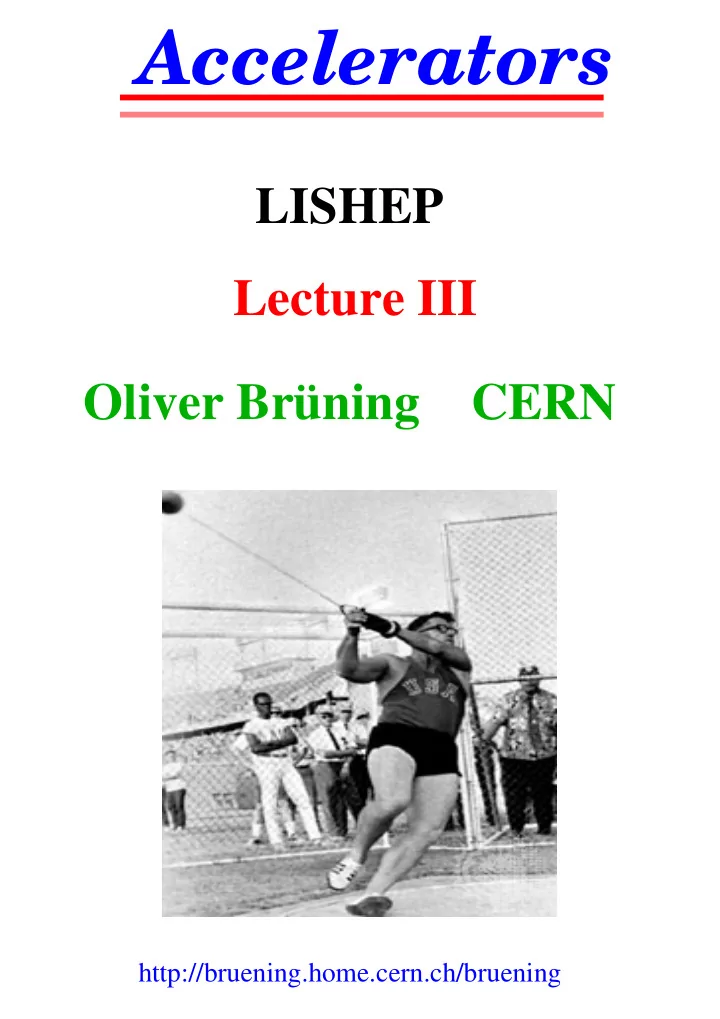

Accelerators LISHEP Lecture III Oliver Brüning CERN http://bruening.home.cern.ch/bruening
LHC Performance Goals collision energy: Higgs discovery requires: E > 1 TeV CM proton collisions (discovery potential) requires: E > 5 TeV beam requires strong magnetic fields instantaneous luminosity ´L´: σ number of events in detector / sec = L event −1 −2 33 rare events: L > 10 cm sec integrated luminosity: = L(t) dt L depends on the beam life time, the LHC cycle, ´turn around time´ and operation efficiency
Choices for the LHC super conducting magnet technology FODO lattice dipole packing factor field quality and resonances 2 in 1 magnet design synchrotron radiation beam screen electron cloud 11 2808 bunches with 10 particles per bunch luminosity insertions luminosity lifetime and operation cycle
The LHC is a Synchrotron Cyclotron: Q γ m B 0 ω = r = v γ m Q B 0 0 Synchrotron: R = const. B = const. injection magnet �������� �������� �������� �������� B �������� �������� �������� �������� �������� �������� �������� �������� �������� �������� �������� �������� �������� �������� �������� �������� �������� �������� �������� �������� RF cavity vacuum chamber extraction / target ω (LHC/LEP: 11.3kHz) = 0
Circular Accelerators R = const. uniform B−field: B L p = Q 2π E / c for E >> E 0 realistic synchrotron: B−field is not uniform: −drift space for installation −different types of magnets −space for experiments etc Q c E = B d l 2π high beam energy requires: −high magnetic field −large packing factor ’F’
Why 8.4 Tesla? required maximum dipole field: γ B p[GeV/c] 2π B[T] = 0.3 F L[meter] p = 7000 GeV/c Physics: LEP tunnel: L = 27000 meter arcs: L = 22200 meter only 80% of the arc are filled with dipoles: F = 0.8 iron saturation: 2 Tesla B = 8.38 T −4 earth: 0.3 * 10 Tesla max
Bending Magnet Amperes Law: µ µ B = H H = I N 0 ����������� ����������� µ >> 1 ����������� ����������� ����������� ����������� coil ����������� ����������� ����������� ����������� h H 0 ����������� ����������� ����������� ����������� ����������� ����������� ����������� ����������� l H E ����������� ����������� yoke beam vacuum chamber field amplification with iron core µ >> 1 Ferro magnetic material field quality is determined by the pole face shape this design principle was used for the LEP magnets
Power Consumption LEP: 2 P = R I B = 0.135 Tesla Ω I = 4500A; R = 1m P = 20 kW / magnet P = 10 MW ca. 500 magnets LHC: B I B = 8.38 T I = 280000 A max (current density!) P > 78 MW / magnet P > 39 GW ca. 500 magnets superconducting technology! 8.4 T is at the limit of available technology!
Bending Magnet saturation magnetic induction B H magnetic field amplification process does not work for fields above 2 Tesla! field quality control via pole face shape does not work for the LHC magnets! use the coil design to determine the field quality cosine field distribution in the magnet cross section generates a uniform vertical dipole field coil precision and stability is a major concern for superconducting magnets!
Superconducting Magnets y r a a B φ I I x B = µ I φ φ [-sin( ), cos( ), 0] 0 r > a: π 2 r µ 0 j r φ φ r < a: [-sin( ), cos( ), 0] B = 2 Overlap the two cylinders: φ φ 2 r cos( ) - r cos( ) = d 2 1 1 p φ 2 φ r sin( ) - r sin( ) = 0 r r 2 2 1 1 A 1 B x y B = const. y in C B = 0 x C j = 0
Superconducting Magnets conventional magnets: −field quality given by pole face geometry −field amplified by ferromagnetic mat. −iron saturates at 2T −Ohmic losses superconducting magnets: −no Ohmic losses −field quality given by geometry −magnets can quench −field quality changes with time
Super conducting Magnets super conducting state: parameterized by 3 parameters −high ambient magnetic field lowers the capability of sustaining high current densities −low temperatures increase the capability of sustaining high current densities 2 LHC: B = 8.4 T; T = 1.9 K; j = 1−2 kA / mm small margins for temperature and mechanical stress! He at 2K is super fluid and has high therm. conductivity
Superconducting Cable: cable NbTi ������ ������ ������ ������ wire ����������� ����������� ������������ ������������ ������ ������ ������ ������ �������� �������� + ����������� ����������� ������ ������ ������ ������ �������� �������� ����������� ����������� ������������ ������������ ������ ������ ������ ������ �������� �������� ����������� ����������� ������ ������ ������ ������ �������� �������� ����������� ����������� ������������ ������������ ������ ������ Cu ������ ������ �������� �������� ����������� ����������� ������������ ������������ ������ ������ ������ ������ �������� �������� ����������� ����������� ������������ ������������ ������������ ������������ ������ ������ ������ ������ �������� �������� ����������� ����������� ������������ ������������ ������ ������ ������ ������ �������� �������� ����������� ����������� ������������ ������������ ������������ ������������ ������ ������ ������ ������ �������� �������� ����������� ����������� ������������ ������������ ������ ������ ������ ������ �������� �������� ����������� ����������� ������������ ������������ ������������ ������������ ������ ������ ������ ������ � � � � �������� �������� ����������� ����������� ������������ ������������ ������ ������ � � � � �������� �������� ������������ ������������ � � � � �������� �������� � � � � �������� �������� ������������ ������������ � � � � �������� �������� � � � � �������� �������� ������������ ������������ � � � � �������� �������� ������������ ������������ � � � � Coil Winding: superconducting cable beam vacuum pipe Δ B Persistent Currents: e B = −c rot E e t Ι Ι
Superconducting magnet design cable and filiaments
Recommend
More recommend